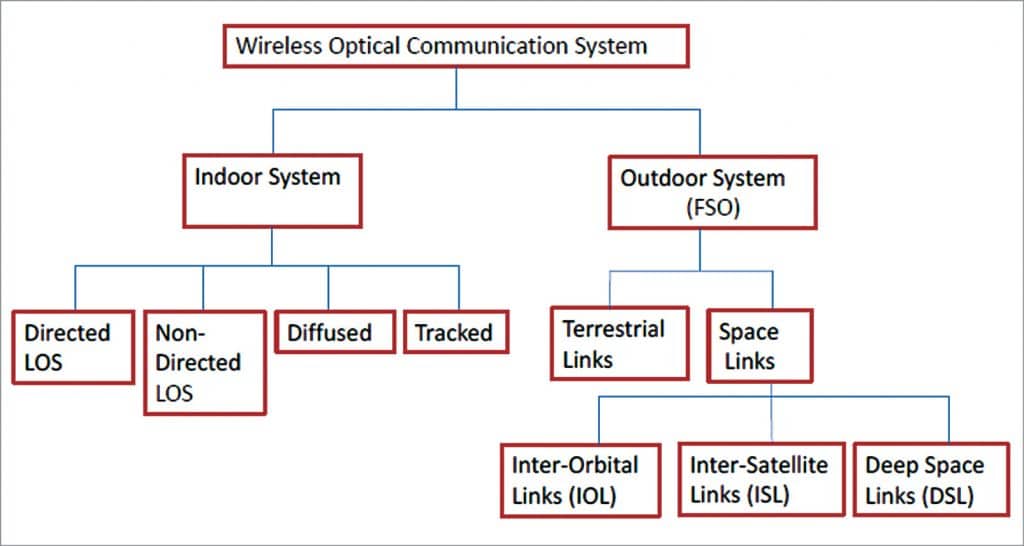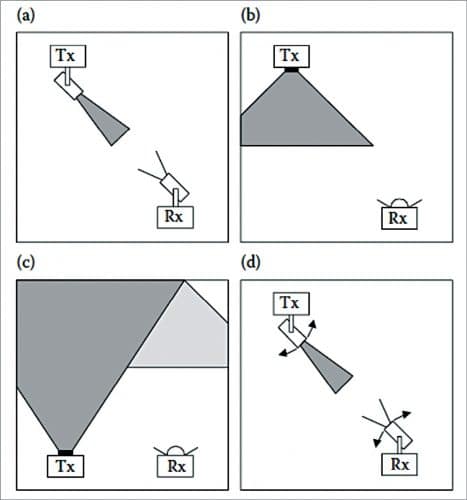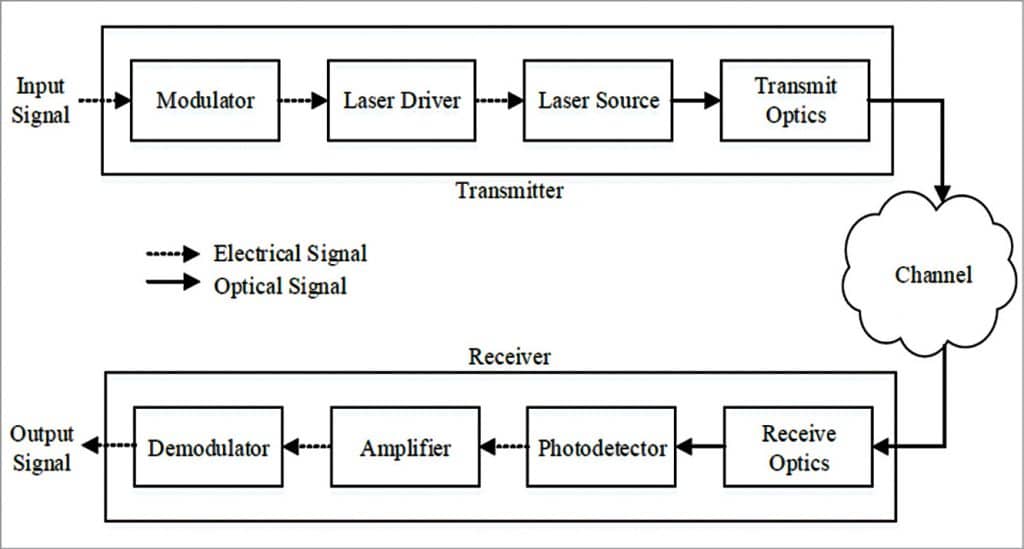Wireless optical communication (WOC) uses optical carrier in the near-infrared (IR) and visible bands and is considered a viable solution for achieving high-speed and large-capacity communication links.
The arena of wireless communication is mostly dominated by radiofrequency (RF)-based technologies. The constant growth in Internet data traffic is challenging the existing technologies to provide higher throughput, better security, and lower cost. Along with RF, wireless communication also includes the systems that use the infrared (IR) regime of the electromagnetic spectrum. These systems are commonly coined as wireless optical communication (WOC) systems. The use of light in communication was ignited by the demonstration of the first working laser at Hughes Research Laboratories, California, in 1960. With the significant development in optoelectronic components and the market ecosystem over the last few years, WOC has gone through tremendous development.
Indoor and outdoor wireless optical communication
As a broad classification, WOC can be divided into two categories: Indoor WOC and outdoor WOC, commonly known as free-space optical (FSO) communication.
The sub-division of the indoor WOC system is based on the viewing angle of the transmitter and receiver.

Directed LOS system
In this type of WOC system, both the beam angle of the transmitter and field of view of the receiver are very narrow, allowing point-to-point or line-of-sight (LOS) communication. The alignment of the receiver and the transmitter is very crucial to achieve the quality of service. Blocking in the LOS path breaks the communication.
Non-directed LOS system
This type of indoor system is suitable for point-to-multipoint communication. The beam angle of the transmitter and field of view of the receiver are wide enough to avoid any stringent alignment requirement. This system allows limited user mobility.
Diffused system
In this type of system, the transmitter is faced towards the ceiling. The light is reflected from the ceiling and walls multiple times to reach the receiver having a wide field of view. Due to multiple paths from the transmitter to the receiver, this system does not suffer from blocking in the LOS path.
Tracked system
In a tracked system, the receiver and the transmitter can track each other. Mechanical or electronic control needs to be implemented for effective tracking.
Terrestrial links
Terrestrial FSO system is used for building to building communication or metro area extension. This is primarily an LOS communication. It has applications in disaster recovery and x-haul of 3G/4G/5G mobile communications.
Space links
An inter-satellite link is a communication between two low Earth orbit (LEO) satellites. An inter-orbital link is established between LEO and geostationary Earth orbit (GEO) satellites. Tight alignment and tracking, low power consumption, and being lightweight are critical requirements for space applications.

The architecture of WOC system
A WOC system consists of three major subsystems: Transmitter, channel, and receiver. The block diagram of an FSO communication system is shown in Fig. 3. The role of transmit optics and receive optics are analogous to the antenna used in RF communication.

Transmitter
The role of the transmitter is to convert the information to a signal form suitable for transmission over the channel. The modulator modulates the information signal and drives the laser driver. The laser diode acts as the optical source that converts the information in the electrical domain to an optical signal. The transmit optics collects the laser light and directs it towards the receiver.
Channel
For the WOC system, the channel can be vacuum, atmosphere, or water. In case of the atmospheric channel, the signal faces random attenuation due to effects like fog, haze, cloud, and rain. Atmospheric turbulence is caused by random fluctuations of the refractive index of the medium due to random temperature fluctuations. Atmospheric turbulence is the main limiting factor for the performance of an FSO communication link.
Receiver
In the receiver, the incident optical signal is captured by the receive optics, and it focuses this signal on the photodetector. The photodetector converts the optical signal to its electrical form. Then the amplifier amplifies the signal and also increases the signal-to-noise ratio (SNR). Finally, the demodulator gives an estimate of the input signal.
Wavelengths used in WOC system
The choice of wavelength is dependent on multiple factors like atmospheric effects, attenuation, eye safety regulations, availability, cost of components, and background noise power. Overall wavelength bands are the same as used in optical fibre communication.
The majority of FSO communication systems are designed to operate in the windows of 780-850nm and 1520-1600nm. The benefit of using these bands is that the components are readily available as these are used in fibre optic systems and other industrial and consumer applications.
Antenna gain is inversely proportional to the wavelength of operation. So, operating in lower wavelength bands is beneficial. But eye-safety regulations allow transmitting much more power in higher wavelengths.
Advantages of WOC system
The WOC system has several advantages over RF communication system due to the shorter wavelength of operation.
Higher bandwidth
An increase in carrier frequency increases the information-carrying capacity of a communication system. In optical communication, the usable bandwidth is almost 105 times of that in the RF communication system.
Unlicensed spectrum
Till now, there is no licensing requirement for the establishment of an FSO communication link. It makes the development and deployment of an FSO communication system easier.
Better security
The beam divergence is proportional to the wavelength. As in the case of WOC communication, the operating wavelength is much less than of RF communication, and the beam divergence is significantly less. As the beam is confined in a narrow region, it provides better security and power efficiency.
Less mass and power
Due to narrow beam divergence, the received power intensity is higher for a given transmitted power. It allows a simpler and lighter transmitter and receiver design. Antenna gain is inversely proportional to the square of the operating wavelength. A small antenna in the WOC system can achieve higher gain.
Disadvantages of WOC system
LOS requirement
Due to a very narrow beam divergence, LOS is a critical requirement for successful communication.
Pointing and tracking requirement
Again, due to narrow beam divergence, even building vibrations pose a severe issue to the establishment of a good communication link. Accurate pointing and tracking systems need to be deployed for reliable operation.
Atmospheric effects
WOC communication is highly impacted by haze and fog due to the high attenuation of optical signals. Random temperature variations in day time cause random variation of the refractive index of the air. This atmospheric turbulence causes random intensity variation in the receiver.
Background noise power
The relative position of the sun with respect to the transmitter and receiver plays a crucial role. Sun is a potential source of background noise. Under certain conditions, background noise may severely impair a WOC link.
Applications
WOC communication has versatile applications. Key application areas are:
- Building to building communication
- Disaster recovery applications
- Satellite and deep space links
- As a backup to an existing optical fibre link
- X-haul to 3G, 4G, and 5G mobile communication system
The FSO system is gaining rapid popularity for Gbps capable communication link. The research works on WOC system focus to mitigate the atmospheric effects and enhance throughput under various atmospheric conditions. The use of sophisticated forward error correction techniques and aperture averaging are some of the enablers for a robust communication link.
Arka Mukherjee is a post-graduate and gold medallist from IIT Delhi. He has more than eight years of experience in embedded systems design for optical access system




